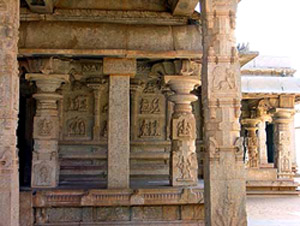 Temple of Ramachandra also called as Hazara Rama is in the heart of the palace grounds. This temple is devoted to Rama as an incarnation of Vishnu. The temple is of medium size, it has entrances in the east and north and has a low wall. The wall has a design of animals, musicians sculpted in many layers. This temple has a square Mandapa with three sided entrance like any other chalukya type temples. There are life size figures of amorous couples, flower bearers and angels decorating the pillars of the mandapa. The design also has a sense of southern type decorations. This temple holds a Amman Garbhagriha which was added later and holds more ornate sculpture than the rest of the temple walls.
Temple of Ramachandra also called as Hazara Rama is in the heart of the palace grounds. This temple is devoted to Rama as an incarnation of Vishnu. The temple is of medium size, it has entrances in the east and north and has a low wall. The wall has a design of animals, musicians sculpted in many layers. This temple has a square Mandapa with three sided entrance like any other chalukya type temples. There are life size figures of amorous couples, flower bearers and angels decorating the pillars of the mandapa. The design also has a sense of southern type decorations. This temple holds a Amman Garbhagriha which was added later and holds more ornate sculpture than the rest of the temple walls.
This article is a stub. You can enrich by adding more information to it. Send your Write Up to content@indianetzone.com





















